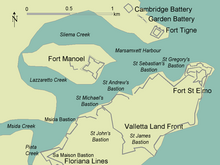Cambridge Battery
The Cambridge Battery is a fortification in Malta . It was built from 1878 to 1880 during the British rule over the islands. It is located on the northeast coast on the headland called Dragut's Point north of the entrance to Marsamxett Harbor, right next to Fort Tigne . It was used to accommodate a RML 17.72 inch gun .
prehistory
Immediately after the British took over the islands in 1800, the fortifications built by the Order of St. John were used almost unchanged. In accordance with the military theoretical ideas of the time, the Royal Navy operating in the Mediterranean was seen as the most reliable protection against an invasion of the islands. The situation changed, however, with the merging of the fleets of Sardinia , the Bourbons, Sicily and the Papal States on November 17, 1860 and the establishment of the Regia Marina Italiana on March 17, 1861. The beginning of the armament of the Italian fleet was seen by the British as a threat to them felt dominant role in the Mediterranean. In 1873 the Regia Marina laid the battleships Caio Duilio and Enrico Dandolo on Kiel. Equipped with four 450 mm cannons each and heavily armored, they were 15 knots faster than the British ships of that era. At the same time, artillery was revolutionized with the introduction of cannon firing shells.
The emerging development made it clear that the fortifications on Malta had to be strengthened. At the time, Malta was the most important British naval base in the Mediterranean after the Suez Canal . Securing the accesses to the ports with the Rinella and Cambridge Batteries and strengthening the fortifications in the Grand Harbor area had the highest priority.
The first cannon was transferred to the Cambridge Battery on September 16, 1882 and erected there on February 20, 1884. The trial shooting could only begin in 1885 because work was still to be done. Between 1887 and 1888, the operational readiness was restricted by problems with the hydraulic systems. Nevertheless, the weapons were judged to be quite reliable overall. The cannons were decommissioned in 1906, although they were last fired in 1903 and 1904. Reactivation was considered during World War I when the islands were threatened by the Goeben operating nearby . Compared to the modern armament of the Goeben , the range and cadence of these cannons were completely inadequate.
construction
The Cambridge and Rinella Batteries are constructed identically. Both have the shape of a pentagon with a width of 71 m and a height of 66 m. The walls of the battery are about 6 m thick. The entire complex was surrounded by a 5 m wide trench. In the sea-side trench there were a total of 3 trench strokes to combat infiltrated infantry. Access was possible through the ditch and a passage in the landside wall.
The facility consisted of two floors. The firing position, which was only protected by a relatively low parapet, was on the upper floor. The cannon was set up in it in a pivot arrangement . On the lower floor there were two ammunition bunkers and the steam engine to drive the hydraulic directional drives of the cannons.
For loading, the cannons were withdrawn from their firing position, the barrel was lowered and swiveled 90 degrees to the right or left to the side. The pipe was then loaded from the front from one of the bunkered charging stations. 250 kg of propellant charge and the projectile were pressed into the barrel with a hydraulic ram. The tube was then turned again and moved back into the firing position.
The gun did not have a barrel return mechanism . In order to absorb the forces of the recoil, a special carriage construction was necessary. The lower mount was rotatably mounted on a solid base. A carriage with 18 wheels was placed on this lower carriage, which took the trunnion of the cannon. The car's path was inclined 4 degrees to compensate for the recoil. The car returned 1.75. Two hydraulic dampers at the rear of the lower mount limited the path of the car and absorbed the remaining recoil forces. The car weighed 20.680 kg, the lower mount 24.118 kg and the base 2.032 kg. A hydraulic system for side and height was used for straightening.
The crew consisted of 35 men, of which 18 were needed for the ammunition.
The cost of building the facility after completion was £ 18,890.
Use from the Second World War
During the Second World War there were no firing positions in the battery.
The Cambridge Battery and the military buildings surrounding it are given historical and, in some cases, architectural value. In addition to the connection to the British period, they make a significant contribution to the character, identity and local uniqueness of the island. After the end of the Second World War, the battery was demilitarized and handed over to civilian use. Since awareness of the island's military legacy from the British period did not develop until the turn of the millennium, the battery, like most military systems from this period, was used inappropriately and in some cases was deeply encroached on the existing structure. However, essential parts of the battery are still preserved. The existing development plan provides for the Cambridge Battery and the Garden Battery to be retained and their integration into the new development.
See also
Individual evidence
- ↑ Captain JM Wismayer: British Fortifications in Sliema (1814-1943). In: Kunsill Lokali Tas-Sliema: Lehen il-Kunsill Tieghek, 2007
- ^ A b c Malta Environment and Planning Authority: Fort Cambridge Area Development Brief, 2005
literature
- Charles Stephenson: "The Fortifications of Malta 1530-1945", Osprey Publishing Limited, 2004, ISBN 1-84176-836-7
- Denis Castillo: "The Maltese Cross, a Strategic History of Malta"
- Captain JM Wismayer: British Fortifications in Sliema (1814-1943). In: Kunsill Lokali Tas-Sliema: Lehen il-Kunsill Tieghek, 2007
- Malta Environment and Planning Authority: Fort Cambridge Area Development Brief, 2005






